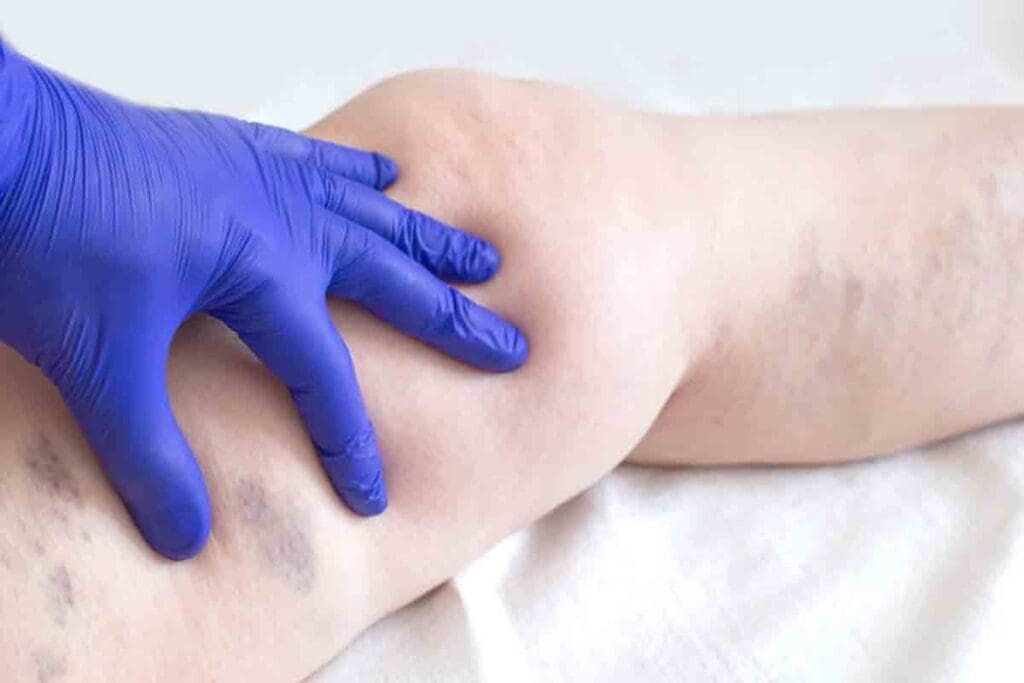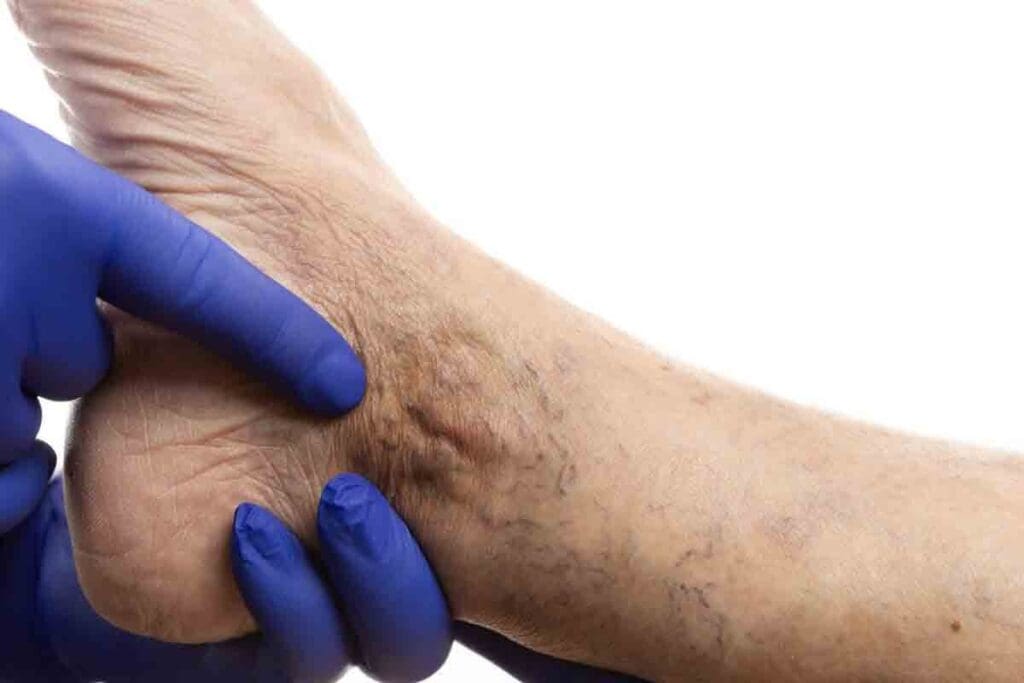Last Updated on November 17, 2025 by Ugurkan Demir

At Liv Hospital, we know how serious Deep Vein Thrombosis (DVT) is. It’s when a blood clot forms in a deep vein, usually in the leg. The CDC says up to 900,000 Americans get DVT or pulmonary embolism (PE) each year. Sadly, 60,000 to 100,000 people die from it.
It’s important to know about DVT to get help quickly. We’ll look at seven key facts about DVT. This includes what causes it, its symptoms, and how to treat it. Our goal is to help you understand and manage DVT.

Deep Vein Thrombosis (DVT) is a condition where a blood clot forms in a deep vein, usually in the legs. The deep veins are inside the muscles of the legs. This is where DVT most often happens.
DVT is when a blood clot forms in the deep veins. It’s a serious condition that can cause inflammation and serious problems. The term “thrombosis” means a blood clot in a blood vessel. “Deep vein” means the clot is in the deeper veins, not the ones closer to the skin.
“DVT” stands for Deep Vein Thrombosis. In medical talk, DVT is what this condition is called. Other terms like “venous thromboembolism” (VTE) include DVT and pulmonary embolism (PE), a serious complication of DVT.
Doctors say DVT is a big cause of sickness and death, mainly in people in the hospital or after big surgeries. This shows how important it is to understand and manage DVT well.
The veins most often hit by DVT are in the lower legs. These include:
These veins are more likely to get clots because of things like blood stasis, hypercoagulability, and injury to the inner lining of the veins.
| Vein | Location | Frequency of DVT |
| Femoral vein | Thigh | High |
| Popliteal vein | Behind the knee | Moderate |
| Iliac vein | Pelvis | Moderate |
| Deep calf veins | Lower leg | High |
Knowing which veins DVT affects is key for diagnosing and treating it. Doctors use imaging like ultrasound to see the clot and figure out how bad DVT is.
As we keep learning about DVT, it’s important to know the risks, symptoms, and treatment options. We’ll cover these in the next parts.
Deep Vein Thrombosis (DVT) is a serious condition that affects millions worldwide. It’s important to know the key facts about DVT to prevent and treat it. We need to understand how widespread DVT is and its long-term effects.
The Centers for Disease Control and Prevention (CDC) says up to 900,000 Americans get DVT or Pulmonary Embolism (PE) each year. This shows how big of a problem DVT is in the US.

DVT is a big problem worldwide, causing a lot of sickness and death. It also costs a lot of money in healthcare. In the US, between 60,000 to 100,000 people die from DVT or PE every year.
DVT is a big part of Venous Thromboembolism (VTE), which also includes PE. Knowing how DVT and VTE are connected is key to treating them well. VTE is a serious disease that needs quick diagnosis and treatment.
People who have had DVT are at high risk of getting it again, mostly in the first year. How well someone does long-term depends on many things, like their health and treatment.
| Condition | Annual Incidence (US) | Mortality Rate |
| DVT | Up to 900,000 | 60,000 to 100,000 |
| VTE | Up to 1 million | Higher than DVT alone |
Knowing the important facts about DVT helps doctors and patients. By understanding DVT’s impact and long-term effects, we can improve how we prevent, diagnose, and treat it.
Seeing how DVT forms helps us understand it better. Deep Vein Thrombosis is when blood clots form in deep veins, usually in the legs. Knowing how these clots form and grow is key for diagnosing and treating them.
A DVT diagram is a great tool to show how blood clots form. The process starts with changes in blood flow, a tendency for blood to clot more easily, and damage to the vein lining.
First, the coagulation cascade is activated, leading to a thrombus. This thrombus can grow and block blood flow, causing DVT symptoms.
DVT can be divided by where it happens in the veins. Proximal DVT is in veins like the femoral and iliac, while distal DVT is in the calf veins.
| Characteristics | Proximal DVT | Distal DVT |
| Location | Femoral, iliac veins | Calf veins |
| Risk of Pulmonary Embolism | Higher | Lower |
| Symptoms | More pronounced | Less pronounced |
The growth of venous thrombosis can lead to serious issues like pulmonary embolism and post-thrombotic syndrome. Knowing the risk factors and how DVT progresses is vital for effective treatment.
By understanding DVT’s pathophysiology and the differences between proximal and distal DVT, healthcare professionals can improve diagnosis and treatment. This leads to better patient outcomes.
Knowing the main risk factors for DVT helps in preventing it. We will look at the key factors that raise the chance of getting DVT.
Hospital stays and surgeries are big risks for DVT. People having major surgeries, like orthopedic ones, face a higher risk. Being stuck in bed and the surgery itself make clots more likely.
Key factors related to hospitalization and surgery include:
Cancer and its treatment, like chemotherapy, raise DVT risk. Some cancers, like pancreatic, brain, and ovarian, are more linked to DVT.
The link between cancer and DVT is multifactorial:
Pregnancy and after childbirth are risk times for DVT. Pregnancy’s blood volume and leg pressure changes increase this risk.
Other things can also up DVT risk. These include:
| Risk Factor | Description |
| Family History | A history of DVT in first-degree relatives |
| Age | Increased risk with age, over 40 |
| Obesity | Higher body mass index (BMI) increases risk |
| Immobility | Prolonged periods of inactivity |
Knowing these risk factors is key to preventing and catching DVT early. By spotting signs and taking steps to prevent, we can lower DVT rates and its bad effects.
It’s key to know the signs of Deep Vein Thrombosis early. DVT can show up in different ways. So, it’s important to know the common symptoms.
The main signs of DVT are leg swelling, pain, and redness. These happen because the blood flow is blocked by a clot. The pain feels like a cramping sensation that gets worse.
You might also see warmth or tenderness in the leg. Sometimes, the skin turns red or purple because of the clot.
Not everyone with DVT shows symptoms. Asymptomatic DVT is dangerous because it can be missed until it’s too late.
Many DVT cases don’t show symptoms. Knowing the risk factors and taking steps to prevent it is very important.
Some symptoms need urgent care. If you have severe chest pain, trouble breathing, or coughing up blood, get help right away. These could mean a pulmonary embolism, a serious DVT complication.
DVT symptoms can look like other issues, like muscle strain or cellulitis. Getting a proper diagnosis from a doctor is vital.
Tests like ultrasound can confirm a clot. Knowing your risk and telling your doctor about your symptoms helps in making the right diagnosis.
Diagnosing DVT needs a detailed plan. This includes checking the patient, using imaging, and lab tests. We aim to give patients the right treatment quickly and accurately.
First, we check the patient’s history and symptoms. We look at their risk factors too. This helps us decide if they might have DVT. We use scores like the Wells’ score to help decide what tests to do next.
The Wells’ score helps us guess if someone has DVT. It looks at things like cancer, recent immobility, and vein tenderness. This helps us know if we need to do more tests.
Ultrasound is key for finding DVT. It’s safe and shows us the veins in real-time. It can spot clots. Compression ultrasound is great because it shows if a vein can’t be compressed, a sign of DVT.
Other tests like venography and MRI might be used too. Venography uses contrast to see clots. MRI gives detailed vein images. These tests are for when ultrasound isn’t clear enough.
Labs are important for DVT diagnosis. The D-dimer test checks for a protein from dissolving clots. A negative test helps rule out DVT in low-risk patients. But, a positive test needs more tests to confirm.
We also do other lab tests. These check the patient’s health and find reasons for DVT. Tests include blood counts, coagulation profiles, and liver tests.
It’s key to confirm proximal DVT. This is because it’s more dangerous. We use clinical checks, imaging, and lab results to confirm. Proximal DVT is in veins like the femoral or popliteal.
After confirming, we start treatment. Treatment depends on the clot size, patient health, and other conditions. This helps prevent more problems and lowers the chance of DVT coming back.
Managing Deep Vein Thrombosis (DVT) needs a detailed plan. Every patient is different, so we tailor our approach to fit their needs.
Anticoagulation therapy is key in treating DVT. It stops the clot from growing and lowers the chance of pulmonary embolism. We use direct oral anticoagulants (DOACs) and low molecular weight heparin (LMWH) to keep the blood flowing right.
Choosing the right anticoagulant depends on many things. This includes the patient’s kidney health, risk of bleeding, and other medicines they take. Close monitoring is key to adjust the treatment and avoid side effects.
Thrombolytic therapy is for those with big DVTs or high risk of problems. It uses medicines to break down the clot and get blood flowing again. But, it can raise the risk of bleeding.
Sometimes, we need to use special procedures to treat DVT. Catheter-directed thrombolysis and mechanical thrombectomy can clear the clot. These are for severe cases or when other treatments don’t work.
How long it takes to recover from DVT depends on the case. We stress the need for follow-up care. This is to watch for problems, adjust treatment, and teach patients how to manage their condition.
With a detailed treatment plan, we can help patients with DVT get better. This reduces the chance of long-term issues.
Deep Vein Thrombosis can lead to serious complications if not treated right. We’ll look into these complications to see why quick medical help is key.
Pulmonary embolism is a severe DVT complication. It happens when a blood clot travels to the lungs. This can block blood flow and cause serious health problems, even death. The risk of pulmonary embolism is highest in the first few days after the clot forms, but it can happen at any time.
Understanding that a blood clot in DVT is not just a local issue is important. It can travel to the lungs and cause a pulmonary embolism. This condition needs immediate medical attention.
Post-thrombotic syndrome (PTS) is a long-term issue from DVT. It causes ongoing pain, swelling, and skin color changes in the affected limb. Managing DVT well is key to avoiding PTS.
PTS happens because the blood clot damages veins and valves. Using anticoagulation therapy can help lower the risk of PTS.
Recurrent DVT is a big worry. It means the first clot didn’t fully go away or new ones are forming. Managing it means finding out why it’s happening and changing treatment plans.
It’s important to watch patients with DVT history for signs of it coming back. They might need longer anticoagulation therapy or other treatments.
DVT’s long-term effects can be big, like chronic venous insufficiency and post-thrombotic syndrome. Knowing these effects is key to caring for patients fully.
Managing DVT long-term means treating the immediate issue and thinking about long-term effects. This includes making lifestyle changes and ongoing medical care to lower risks.
Deep Vein Thrombosis (DVT) is a serious condition that needs quick diagnosis and treatment. We’ve looked into DVT’s causes, symptoms, and how to treat it. Knowing about DVT helps find it early and manage it well.
We talked about big risk factors like being in the hospital, having cancer, or being pregnant. These can make you more likely to get DVT. Spotting symptoms like leg pain and swelling is key to getting help fast. Tests like ultrasound and D-dimer help confirm DVT.
Managing DVT involves treatments like blood thinners and procedures. Understanding DVT’s details shows why quick medical help is so important. This summary on DVT stresses the need for awareness and education. It’s vital for better patient care.
Deep Vein Thrombosis is a serious condition where a blood clot forms in the deep veins, usually in the legs. It can be deadly if the clot moves to the lungs, causing a pulmonary embolism.
The veins most often hit by DVT are the femoral and popliteal veins. The deep veins of the calf are also commonly affected.
Big risks for DVT include being in the hospital, having surgery, or having cancer. Pregnancy and the postpartum period also increase the risk. Other factors include being immobile, having trauma, or having a family history of DVT.
Symptoms of DVT include pain, swelling, and redness in the leg. Some cases have no symptoms. But, look out for severe pain, trouble breathing, or feeling like you’re going to die.
Doctors use a few ways to find DVT. They look at symptoms, use ultrasound, and do blood tests like D-dimer analysis.
To treat DVT, doctors use medicines to stop the clot from growing. They might also do procedures to break up the clot. After treatment, patients need to follow up to avoid more problems.
DVT can lead to serious issues like pulmonary embolism and post-thrombotic syndrome. It can also cause DVT to come back, leading to long-term pain and swelling.
Some risks can’t be changed, but there are steps to lower the chance of getting DVT. Moving around, wearing compression stockings, and taking medicines can help.
Anticoagulation therapy is key in treating DVT. It stops the clot from getting bigger, lowers the chance of pulmonary embolism, and helps prevent it from coming back.
Proximal DVT happens in the bigger veins closer to the body’s center. Distal DVT is in the smaller veins further away. Proximal DVT is more serious because it’s more likely to cause a pulmonary embolism.
Agency for Healthcare Research and Quality (AHRQ) — Venous Thromboembolism Prophylaxis
Discusses hospital-based DVT prevention including statistics and guidelines.
Subscribe to our e-newsletter to stay informed about the latest innovations in the world of health and exclusive offers!